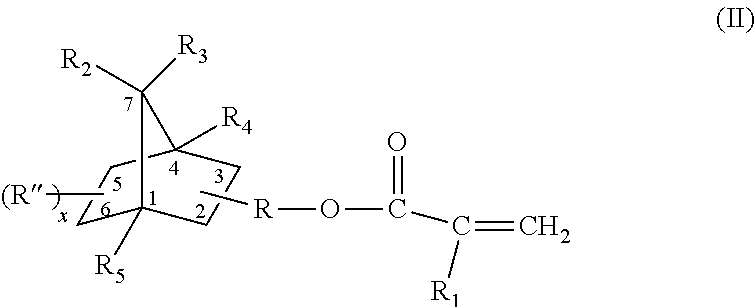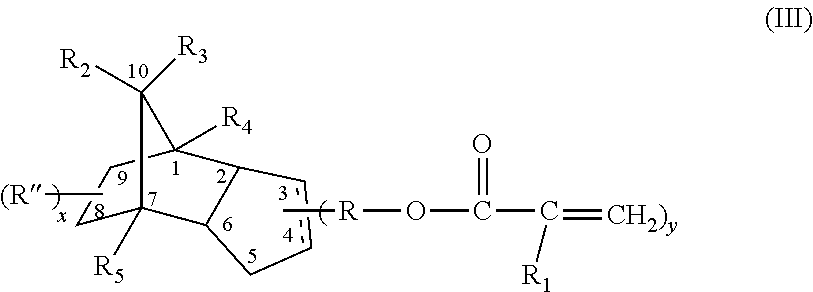Hot melt compositions with improved etch resistance
a technology of etch resistance and composition, applied in the direction of film/foil adhesive, circuit mask, nuclear engineering, etc., can solve the problems of reducing the density and definition of electrically conductive circuitry, affecting the etch resistance of hot melt composition, etc., to achieve good image definition and low flow
- Summary
- Abstract
- Description
- Claims
- Application Information
AI Technical Summary
Benefits of technology
Problems solved by technology
Method used
Image
Examples
examples 1-4
[0067]The following inkjet etch resist compositions were prepared:
Formulation1234MonomersIsobornyl acrylate48 wt %Dicyclopentadienyl50 wt %50 wt %methacrylateTrimethylolpropane triacrylate17 wt %Polybutadiene diacrylate10 wt %Polybutadiene dimethacrylate12 wt %Tricyclodecane dimethanoldiacrylate60 wt %Aliphatic urethane acrylate113 wt %PlasticizersPartially hydrogenated rosinresin220 wt %Hydrogenated rosin resin320 wt %Liquid rosin420% PhotoinitiatorsIsopropyl thixanthone 5 wt % 5 wt %2%2.5 wt % Hydroxycylohexyll phenyl 5 wt % 5 wt %3%2.5 wt % ketoneWaxesCeresin wax10 wt %7.5 wt % Candelilla wax10 wt %Esterified Montan wax10 wt %Montan wax7.5 wt % Myristic acid10%Palmitic acid10 wt %Stearic acid 5 wt %1EBECRYL ® 8309 Acrylic Ester from Cytec Industries2STAYBELITE ® A typical composition and properties: abietic acid 3Hercolyn Floral AX-E from Pinova solutions inc.4Hercolyn D- Methyl Hydrogenated Rosinate from Pinova solutions inc.
[0068]All the formulations were prepared by the same m...
example 5
Etch Resist for PCB Application
[0069]The resist compositions from examples 1-4 were selectively ink jetted from a piezoelectric drop-on-demand print head (Spectra™ SE-128) onto four separate copper clad FR4 / glass epoxy panels at a thickness of 15 μm to 30 μm. The temperature during inkjetting was from 85° C. to 95° C. After the resist compositions were selectively applied to their respective panels, the compositions were exposed to UV light varying from 150-1000 mJ / cm2 using a Fusion D lamp running at 120 W / cm. All the resists cured.
[0070]The hardness of each cured resist is tested using the AS™ D3363-05 pencil hardness test, 5H being the hardest and 1H being the softest. The hardness value for each cured resist was measured to be 4H.
[0071]Each panel was then passed through a conventional etching module containing a commercial ammonia etchant which was a mixture of 5-15% of each of NH4OH and NH4Cl at pH 8.9, 52° C. for 5 min. The copper was etched to a depth of 105 μm. The resist co...
example 6
Etch Resist for Semiconductor Applications
[0073]Solar cells having mono-crystalline or poly-crystalline silicon wafers, a p / n junction and coated with a silicon nitride anti-reflective layer on the front side were provided. Each of the four resist compositions in Examples 1-4 were selectively coated on the anti-reflective layers by inkjet Each resist was applied to one of the two types of silicon wafers. The resists were then exposed to UV light of 150-1000 mJ / cm2 to cure the resists.
[0074]Each solar cell was then immersed in a 20% solution of hydrofluoric acid at 30° C., pH=1 for 5 minutes to etch away the uncoated silicon nitride and expose the n+ doped surface of the silicon. The solar cells were then rinsed with tap water for 2 minutes and air dried. An optical microscope was used to observe the cured resist on each solar cell. There was no observable loss of cured hot melt on either solar cell. The cured hot melt appeared to have resisted the acid etch. Each wafer was then dipp...
PUM
| Property | Measurement | Unit |
|---|---|---|
| Mass | aaaaa | aaaaa |
| Mass | aaaaa | aaaaa |
| Acidity | aaaaa | aaaaa |
Abstract
Description
Claims
Application Information
 Login to View More
Login to View More - R&D
- Intellectual Property
- Life Sciences
- Materials
- Tech Scout
- Unparalleled Data Quality
- Higher Quality Content
- 60% Fewer Hallucinations
Browse by: Latest US Patents, China's latest patents, Technical Efficacy Thesaurus, Application Domain, Technology Topic, Popular Technical Reports.
© 2025 PatSnap. All rights reserved.Legal|Privacy policy|Modern Slavery Act Transparency Statement|Sitemap|About US| Contact US: help@patsnap.com



